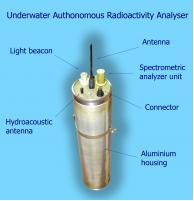Projects
THE SYSTEM FOR MONITORING OF UNDERWATER POTENTIALLY DANGEROUS OBJECTS
One of the most significant problems of environmental safety of Russian Federation is a problem of long-term monitoring of underwater potentially dangerous objects (UPDO) containing radioactive, chemical toxic components and explosives.
SEATECHRIM Company conjointly with a number of companies and Scientific Institutes have been designing and manufacturing components and subsystems for monitoring of such objects for last two years. The project allows to provide data on pollution rate for the Monitoring Center located in the Ministry of Emergency of Russian Federation.
The integrated information system controlling the condition of underwater potentially dangerous objects being under development includes but is not restricted to the monitoring of the following objects:
- the sources of radiation pollution;
- the sources of chemical pollution including submerged chemical weapon;
- objects with explosives;
- other potentially dangerous objects (pipelines, oil wells, submerged vessels etc).
This problem can be solved through development and manufacturing of the autonomous devices for periodical measurements and spectrometric analysis of radiation background in the places where UPDO are located. Such devices would also control toxicity of sea water in the places of UPDO location and transmit the message in case of exceeding the determined level through a satellite communication system after recovery.
Autonomous underwater radioactivity analyser
The operation principle of Autonomous underwater radioactivity analyser is the following:

The Radioactivity Analiser is being deployed at the area where the UPDO is supposed to be located. The system includes radiation spectrometer, radio beacon, electronic microprocessor-based control system, electromechanical anchor release, hydroacoustic antenna, power supply, flashing beacon.
The radiation rate is being measured with specified frequency according to a determined schedule. The SRM recovers to the surface and transmits encoded radio signal if the radiation rate exceeds a determined level set before deployment. The signal is being received by a satellite system and transmitted to the Center of radiation monitoring for recording and analyzing.
The system selectively measures gamma-rays in the specified energy bands. Since gamma-rays consist of gamma-ray quantum with one or several energies and form discrete spectrum the system can uniquely determine radioactive nuclide.
The spectrometric (radiation) analysis unit is based on the scintillation gamma-ray detector with CsJ(Tl) crystal which is optically coupled with photodiode. The unit includes amplifier of the detector signals, multichannel analyzer of pulse amplitude and data storage and processing device.
Autonomous Underwater Analyser
Purpose
- control and estimation of underwater pollution level including poisonous substances
Application
- For long term autonomous underwater monitoring - For operative monitoring as a part of ROV, AUV, towfish
Principle of Operation
Data received by each sensor are stored in nonvolatile AUA memory (cycle time - 1 minute).
AUA sends emergency signal when threshold crossing occurs.
Sensors
Ion-selective (Cl¯ , F¯, CN¯) and cross-selective electrodes (cations K, Na,…, Mg, Ca, Ag, Cu, Cd, Fe, Pb, anions of mineral and organic acids etc.), reference electrode, temperature and electro conductivity sensors. Electrode sensitivity ranges from 10-6 – 10 -5 up to 10-2 – 1 mole/litre.
AUA is waterproof, depth up to 200 meters, optionally – up to 6000 meters.
Sensors service life – 1 year
Dimensions: Ø16х10 cm Weight in air – 3 kg
 seatechrim
seatechrim

